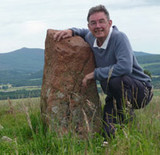The Piper of Dickmount-Law
There is a legend, centuries old, that relates the tale of the 'Piper of Dickmount-Law'.
The story starts with the piper and his wife travelling home, along the nearby coast, severely drunk after attending a wedding.
On the way, they stumbled into a deep coastal cave, known as the Forbidden Cave, which was believed to be occupied by demons, and which no-one dared enter.
Next morning, the piper was heard beneath Dickmount-Law, two kilometres from the coast, sounding his drone, while his wife sang a melancholy song.
Soon afterwards, the piper’s dog was seen to emerge from the cave in a state of distress. The piper continued to play incessantly for several days and nights thereafter, but neither he nor his wife was ever seen again.
There is a lengthy and amusing poem dedicated to this event, which can be read on Google Books.
There is a very similar tale told regarding the Piper's Cave, Uamh an Oir (Cave of Gold) at Harlosh on the Isle of Skye.
|
Hunebed D49 Schoonoord is known as the Papeloze Kerk (church without a priest), a reference to the fact that, in the 16th century, during the Eighty Years War, the Catholic heirarchy forbade Protestants to worship openly. As a result, the Protestants resorted to holding so-called Hagespreken—secret church services held in the open air—often conducted by a lay-preacher rather than a priest, hence the name.
It was rumoured that such services were conducted at the site of the Schoonoord hunebed, which in those days was not surrounded by trees, but was situated in the open treeless heathland of Ellertsveld. The hunebed provided a relatively high look-out point which meant that any uninvited intruders could be detected long before they arrived. It is reputed that Calvinist open air conventicles were held here by the Reverend Menso Alting, although there is no written evidence of this.
The name Papeloze Kerk seems to have been derived from 16th century open-air conventicles held in northern France by the church reformer Jean Calvin, which he called Église Sans Pape. However, the apellation Papeloze Kerk for hunebed D49 only seems to have come into use during the early 19th century.
Nowadays, hunebed D49 is visited yearly for a re-enactment of the hagepreken. Local protestants don historical outfits and a service with music is held around and on top of the dolmen. The service is organised by a historical fellowship, Die Luyden van ‘t Hooge Veene, and the Hervormde en Gereformeerde Kerk. Instead of preaching against the Catholic church of Rome, as was the custom in the sixteenth century, the modern service preaches on fundamental Christianity. The service is held in the regional Drents dialect.
|
|
A keen hillwalker most of my life, my interest was restricted when the need arose to care for an ageing parent.
With limited opportunities to travel far from home, I 'discovered' the world of stone circles, mainly in my native Aberdeenshire.
This provided the ideal opportunity for short walks of just a few hours duration, and resulted in me visiting many places of interest that I had never considered previously.
Website:
Stone Circles of NE Scotland
Here you will find both Google and Bing maps displaying more than 100 sites of stone circles, the majority in my native Aberdeenshire. The markers on the maps are clickable, to reveal a photo of the stone circle and a link to their Canmore Site Record.
A menu at the side of the maps allows you to zoom in to any individual circle, viewing its environs as a zoomable aerial photograph (Google) or an OS Map (Bing).
Hunebedden
I've since extended my interest to the megalithic remains in The Netherlands, where there are some magnificent passage graves known as hunebedden (giant's beds). Despite the fact that The Netherlands is essentially flat and sandy, these 5000 year old monuments from the Funnel Beaker Culture are often found in exquisite woodland settings, nearly all of them in the province of Drenthe. There are almost limitless opportunities for delightful walks between small villages, taking in a diversion to a hunebed here and there.
|

